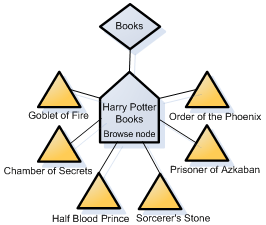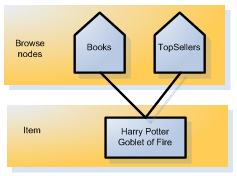Browse Nodes and Items
Browse nodes are categories into which items for sale are organized. A single node might have many items associated with it, as shown in the following figure.

In this example, six items (Harry Potter book titles) are associated with the browse node: Harry Potter Books. This node is a leaf node and a child of the Books parent node. As the figure shows, many items can be associated with a single browse node. What all of the items have in common is described by the name of the browse node.
On the other hand, a single item can belong to more than one browse node, for example, a book might belong to the Books and TopSellers browse nodes.

At a later time, when the book comes off of the top sellers list, the book will be removed from its association with the TopSellers browse node. In this way, you can see that the association between items and browse nodes is dynamic.
Browse nodes are created and deleted as items demand. When, for example, a new toy or group of books starts selling briskly, a node would be created for it. For example, when pet rocks were popular, a node would have been created for pet rock items. When the sales of pet rocks declined significantly, the node would have been deleted. As you can see, some nodes are volatile by nature. For example, the items associated with the browse node, "Top Sellers," change frequently according to sales figures. Other browse nodes, such as Pet Rocks, exist only for a brief time.
Some browse nodes, however, are much longer lived. Top level nodes, for example, "Books" and "Apparel," have remained unchanged for years. So are the browse nodes associated with cities, as shown in the following table.
| City | Browse Node |
|---|---|
| Boston | 917982 |
| Chicago | 917984 |
| New York | 917976 |
| San Francisco | 917980 |
| Seattle | 917978 |
| Washington, D.C. | 917986 |